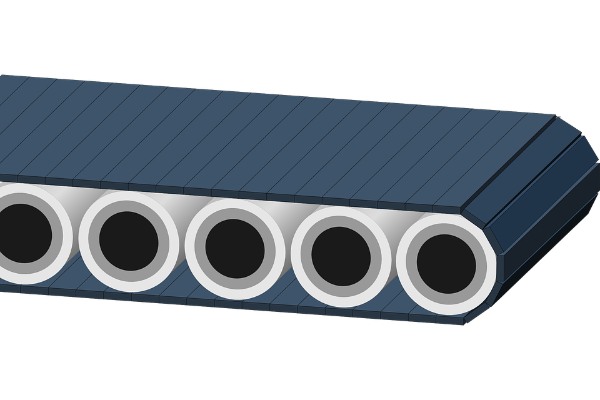One of the most frequent issues experienced by treadmill owners is a slipping belt.
Slipping occurs when a person using a treadmill feels the belt under their feet suddenly move to one side while they are running. The belt is intended to remain fixed in place in the center of the deck. There shouldn’t be any side-to-side movement.
Slipping can be risky. Imagine yourself slipping on a banana peel, which is the traditional falling scenario. The fall doesn’t occur just from standing on the banana peel. The person falls when the banana peel suddenly moves at a completely different angle from how they are moving.
An errant treadmill belt behaves the same way. Even a small change in the ground beneath you can cause you to lose balance while running in one direction and cause you to fall.
The treadmill will continue to move for a brief period of time even if you are using the safety tether, making a fall from a moving treadmill extremely risky.
It’s a stationary object once you touch it down the road. The risk of injury rises when one lands on a moving surface.
Why Is Treadmill Belt Might Be Slipping?
The most crucial step is to identify the cause of your treadmill belt’s slipping. Finding the cause makes it much simpler to fix the issue.
Here are the 5 most common reasons for a treadmill belt to slip:
The Belt Is Too Loose
Due to the extra length, if the belt isn’t fastened tightly enough, it may slide to one side while running.
If this is the cause of your treadmill belt slipping, it is simple to test. Slide your hand under the belt while the treadmill is not running and raise it. It needs to be tightened if it lifts more than 2 to 3 inches.
When tightening the belt, make sure to pay close attention to the directions. To avoid overtightening, tighten it gradually. It’s about the right tightness when you can slide your hand underneath it and it lifts about two inches.
Keep it from being too tightly cinched. In order to get the treadmill moving, the belt must not be too tight. It might end up stressing the motor, causing damage, and preventing the treadmill from running quietly.
Because there is more friction between the belt and the deck below it, the belt will also most likely wear out more quickly.
When adjusting the belt on your own, always remember to reposition it in the center first.
Missing Lubrication
Even the cheapest treadmills need to have their running decks properly lubricated in order to function at their best. Lack of lubrication can cause issues like slipping and sticking on the deck.
The rollers, roller deck, and treadmill belt can all wear out much more quickly than usual due to friction. It’s hazardous because both slipping and sticking can result in missed steps and falls.
You must frequently lubricate your treadmill belt if you want to reduce that friction. To find out how frequently you should lubricate it, check your user manual since this varies by brand and model.
Check the recommended lubricant as well. Avoid utilizing anything different to avoid damaging the treadmill. The most popular option is a silicone-based lubricant because it doesn’t evaporate after application. As they may accelerate the deterioration of rubber components, oil-based lubricants are not advised.
Wear gloves, and be sure to carefully adhere to the directions.
Drive Belt Is Loose
The treadmill deck’s belt is different from the drive belt. Under the deck, the drive belt connects the motor and the first roller. Since it transmits power from the motor to the deck, it is crucial that this belt function properly.
On occasion, the belt will snag and stop moving while the motor keeps running. This could indicate that there is a problem with the front roller and that it needs to be realigned or lubricated.
It can occasionally also stop being driven by a roller and pulley. This is unmistakable evidence that the drive belt needs maintenance. You might feel the belt slip and tremble even if the deck belt is still moving.
A belt dressing, which functions like a lubricant, can be used to treat the drive belt. However, it’s safer to simply replace the belt because incorrect or excessive tightening could harm the pricey machine components.
The Pulley On The Front Roller Lost Grip
The treadmill belt may at times slip off the front roller, which can lead to the belt slipping. The driving roller is in the front, and if it drifts out of alignment, the entire belt could come to a stop.
When the belt stops moving but the drive belt and pulley continue to move, this is what is happening. You must realign the pulley and the roller tube that is located beneath the belt in order to correct this. Sticking a strip of colored tape in a straight line from the pulley to the roller is the simplest way to accomplish this.
Watch for the belt to slip once more as you turn on the treadmill. Turn it off and examine the tape after it happens. If it has separated, your roller and pulley are out of alignment. If not, you must find a different reason.
Sometimes all that’s required is a tightened pulley. It might need to be replaced at other times. It might be best to bring in a professional after looking it over to see which looks likely.
The Belt Is Worn Out
It’s also possible that the treadmill belt is slipping simply from wear and tear from so many feet pounding on it. It can happen, especially if you bought your machine used, use it frequently, or have several users in your home.
Your best option is to replace the surface belt entirely if lubricating the slipping belt doesn’t work or worsens the slipping.

How To Fix Treadmill Belt Slipping
Regular Treadmill Maintenance Lubrication
As previously stated, if improper lubrication is the primary factor causing your treadmill belt to slip, it may be the simplest issue to resolve. A compatible lubricant should be used to lubricate the treadmill belt if you believe that the cause of your belt’s skipping or slipping issue is insufficient lubrication.
The majority of the time, since silicone-based lube doesn’t evaporate, treadmill manufacturers advise using it to keep the belt from slipping. Some manuals do, however, list the precise lubricant that the product’s makers recommend. So make sure to read the manufacturer’s manual before lubricating your treadmill belt! More importantly, an excessively lubricated treadmill belt may raise the possibility of accidents and injuries.
For “no maintenance” treadmills, get in touch with a professional to make sure your treadmill is properly lubricated. As the lubrication procedure varies by model and brand, it is also a good idea to consult the user manual.
Remember to refrain from lubricating your treadmill with oil because doing so can cause the rubber parts of the machine to deteriorate. Wear gloves and pay close attention to the directions when applying the lubricant.
Treadmill Belt Adjustment/ Tightening
Please unplug the treadmill after determining that the treadmill belt is loose. The rear roller bolt on the treadmill’s back should be accessed with an Allen wrench or hex key. The adjustment tool that most treadmills have can be used to tighten or loosen the slipping belt.
Drive Belt Replacement
A loose drive belt can be easily tightened, but doing so is not advised because you risk overtightening the belt. The drive belt’s improper tightening could increase operating amps, stress the motor, or harm some expensive treadmill parts. To prevent further stress on the motor, it is therefore best to replace the loose drive belt. The machine’s drive belt can also be temporarily fixed by spraying a belt dressing on it.
The electric motor hood cover contains the drive belt. Check the user guide before replacing this belt because some treadmill manufacturers forbid removing the hood cover. Additionally, given that performing this kind of treadmill repair frequently nullifies the warranty, some manufacturers don’t advise it.
Worn-out Treadmill Belt Replacement
A worn-out belt may occasionally be kept from slipping by using a straightforward fix like lubricating the treadmill drive belt, pulleys, and rollers. You might think about getting a new treadmill belt, though, if lowering friction is ineffective in solving the issue. For the replacement of a worn-out belt, you can also contact the warranty service provided by the manufacturer of your treadmill.
Repair The Pulley/ Replace The Roller
Turn the treadmill off and check to see if the roller and pulley are aligned properly to see if the belt is slipping. The next step is to fix the treadmill belt by taping a piece of repair tape to the visible portion of the pulley and another piece to the roller tube. As an alternative, use a permanent marker to draw a straight line connecting the roller tube and the pulley.
Now turn on your machine and observe what occurs if the moving belt slips. The pulley has undoubtedly lost its hold if the drive belt and pulley continue to move while the front roller and treadmill belt stop when the machine is running.
If you’re still unsure of what happens when the treadmill belt slips, see if the drawn line or tape separates. The roller and pulley are turning together if the tape or straight line cannot be separated. Consequently, there may be another factor at play in the treadmill belt slipping. However, if they have already split apart, the pulley is now loose, necessitating either a new roller or pulley repair!
However, if you believe that this is beyond your level of technical expertise, seek assistance from a qualified technician.
Conclusion: Regularly Taking Care Of And Maintaining
Since it’s not always a sign that something is wrong with your treadmill, the treadmill belt slipping isn’t a big deal. However, if it happens frequently, the owner or user of the treadmill could suffer serious harm. The cause of the slippage must be identified in order to address the issue as soon as possible.
Fortunately, it shouldn’t be too difficult now that you are aware of some of the factors that might be contributing to that. The best part is that I’ve offered some quick solutions to assist you in fixing these issues. You might need to call a technician to fix some solutions, though, as they might be complicated. Moreover, by regularly caring for and maintaining your treadmill, you can easily avoid some of these problems.
FAQs
How Often Should One Lubricate The Treadmill’s Running Belt?
The running belt should be lubricated every six to twelve months, according to treadmill manufacturers. The type of treadmill lubricant and treadmill model tend to affect this, though.
Can You Use WD40 As A Treadmill Belt Dressing?
Yes, the specially formulated spray known as WD40 is effective at dressing treadmill belts. It reaches the belt’s cord fibers, regaining the elasticity and flexibility of the belt.
How Long Does The Treadmill Belt Last?
A treadmill belt’s lifespan typically varies depending on its type, maintenance, and usage patterns. A 2-ply running belt, for instance, lasts between 5 and 10 years. In contrast, a 1-ply treadmill belt lasts roughly 3 to 5 years or 300 to 500 hours.
Read More: What Do 15 Incline Treadmills Mean?
How To Run On A Treadmill: Treadmill Running Tips For Beginners
